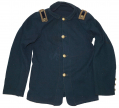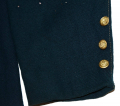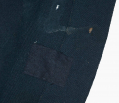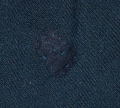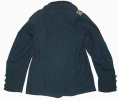site search
online catalog
6th MICHIGAN CAVALRY ID’D CAPTAIN’S FATIGUE BLOUSE: CAPT. WILLIAM HYSER, MICHIGAN CAVALRY BRIGADE
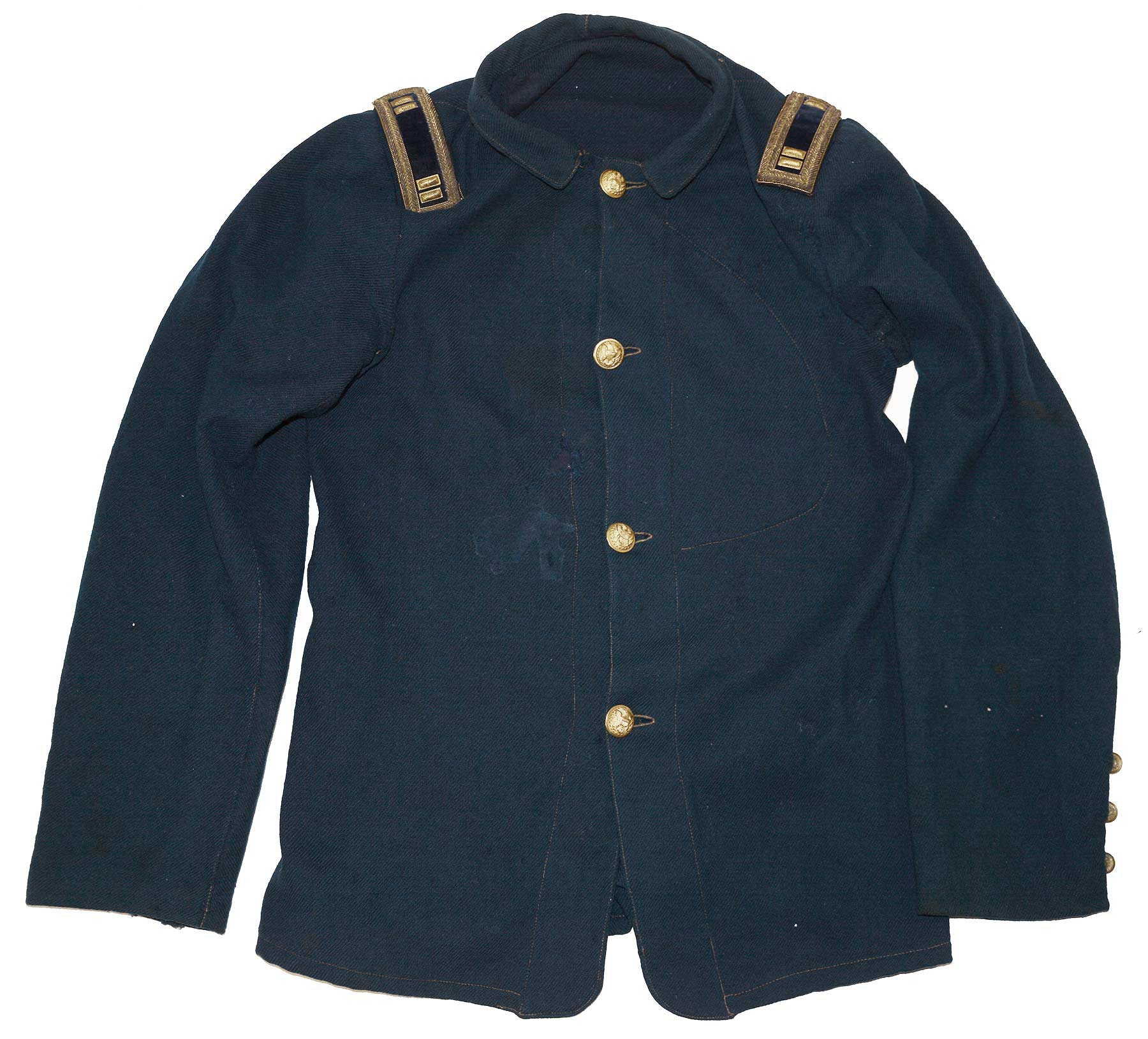
$15,000.00 ON HOLD
Quantity Available: 1
Item Code: 1179-170
Formerly in the collections of the Texas Civil War Museum, this wonderful Civil War officer’s fatigue coat belonged to Captain William Hyser, who served twice as a Captain in the 6th Michigan Cavalry. Hyser served first as Captain of Co. F, from October 1862 until injuries sustained in the cavalry fight at Hanover on June 30, 1863, in the Gettysburg campaign compelled his discharge for disability in October 1863. After recuperating for six months, he obtained a new commission from the Governor of Michigan, again in the 6th Michigan, this time as Captain of Co. D, which he commanded from March 23, 1864, until discharged for the second time on March 23, 1865. In addition to his injuries at Hanover, suffered in the fall of his horse, he was rendered deaf in one ear from the close explosion of a Confederate shell in the fighting at Trevilian Station.
The blouse is in excellent condition, a medium blue wool flannel, with roll-over collar and four-button front, following the regulation issue enlisted pattern, but clearly a privately purchased coat. It is machine stitched, except for the buttonholes, and has three small buttons sewn on the non-functional cuffs and four larger, coat size buttons on the front. All are three-piece staff buttons with Scovill backmarks. The stitching appears original and the thread has oxidized to a light brown. The coat is made of three panels and has an interior pocket in the left breast, as is typical of fatigue blouses, which is made of the same blue flannel as the coat body. The sleeves, made of two pieces, are lined, but the body was not, something not unusual in an era when men commonly wore vests. The sleeve linings are white with printed with red stripes that have blurred from perspiration or been rubbed away from wear in the parts of the shoulders, armpits, and cuffs, though the fabric itself is solid with just some very small threadbare spots inside the cuffs and a short separation of the seam inside wearer’s right sleeve at the shoulder.
There are some scattered pencil-point moth nips. A few not much bigger than a pencil eraser, or a tear, have been reinforced by small patches of dark blue cloth sewn on the inside. We list them as follows for thoroughness, but none are obtrusive. In the wearer’s left panel there is one at the bottom of the armpit (the patch is about 1 by 1.25 inches) and second, (about 1 by .75 inches) is lower down, about even with the lowest buttonhole, 6 inches from the lapel and 7 from the lower edge.) A third slightly larger, about 2 inches wide and 2 inches long at bottom and 4 at top,) runs from the edge of the armpit to the edge of the pocket. The first backs a short tear that has been sewn closed; the second backs a small moth nip. The longer piece backs a couple of pencil point size nips a couple pencil eraser size nips on the upper chest and is a good precaution against them opening further from stress if the coat is displayed on a form. The center panel has two patches: one about 1.75 by 1.25 inches in the area of the right shoulder blade and another in the right shoulder seam near the collar, measuring about 1 by 1.25 inches. Both back pencil eraser size nips. The wearer’s left panel has one patch about 1.5 by 2 inches along the lapel seam, backing an oval hole about .75 long and .5 inches at its largest. We should stress that none of these holes are particularly noticeable. The backing fabric is dark blue and the backing is more a matter of stabilizing the fabric to prevent deterioration from stress. We also see one L-shaped tear that has been sewn closed on the lower right of the central panel, near the lower edge of the coat and next to the seam with the right panel. Again, this evident really on very close inspection and involves no patch or infill of material.
The coat bears a very nice pair of double-bordered gilt bullion shoulder straps, each with pairs of gilt false embroidered captain’s bars at each end. The bullion retains a good deal of its gilt finish, though with some natural and expected rubbing at high points. The strap on the wearer’s left retains all of its jaceron wire borders, inside and out, though it is a tad loose on the back edge. The strap on the right is missing the wire along the inner and outer left edge (closest to the collar.) The straps have very deep blue velvet centers, in excellent condition. These are frequently seen on uniforms worn by officers on staff duty in place of the regulation black and these fit the use of staff buttons on the coat, which also retain a lot of gilt finish on the lapel buttons, and less on the cuffs. We have not pulled all of Hyser’s muster rolls, but expect he did some temporary staff duty at the regimental, brigade level, or higher, or at a post where the regiment was stationed. The identification is secured by a small stencil in the upper shoulder of the right sleeve, about two inches from top, done in purplish ink. The top line is slightly rubbed and blurred, but reads pretty clearly, “CAPT. W. HYSER.” A second line seems reads “MICH.” on the right half, below Hyser’s initial and last name, with the left portion not legible, but likely bearing the regimental designation.
Hyser was born in Herkimer County, New York in 1826 and studied medicine at Geneva and Buffalo, NY, from 1846 to 1850, when he moved to Plainfield, Kent County, Michigan, and set up practice, listing himself as an “allopathic physician” and later as surgeon as well. He also acted as local postmaster in 1861 and again in 1870. His house still stands and is a local museum.
He entered service at age 36 as Captain of Co. F of the 6th Michigan Cavalry at the organization of the regiment, joining it at Grand Rapids in September 1862 with his commission dating to his muster on 10/13/1862. The regiment left the state for Washington in December and in addition to later serving under Custer is well known for having been armed with the new Spencer rifle, giving it a very large boost in firepower. It served in the Department of Washington, took part in two raids into Virginia, and spent the Spring on picket duty near Fairfax Court House and Vienna, Va. In June 1863 they became part of the cavalry corps of the Army of the Potomac, serving in Kilpatrick’s Division and in a brigade taken over by newly promoted Brigadier General George Armstrong Custer. Hyser was present for their introduction their new brigade commander, made under fire on June 30 at Hanover, Pa., a sharp little engagement where Custer and Farnsworth managed to turn aside Stuart’s cavalry and keep them for a while longer from rejoining Lee’s main army. The regiment was active in the rest of the campaign as well: at Hunterstown July 2, the East Cavalry Field at Gettysburg on July 3, and in the pursuit of Lee, fighting at Monterrey, Smithfield, Boonsboro, Hagerstown and Williamsport. Hyser was injured in the fighting at Hanover by the fall of his horse, which landed on his right leg, and severely injured his ankle. We do not know if he was immediately sidelined by this. He may have toughed it out: in the paperwork we have he seems to have first been treated in the Cavalry Corps Hospital on or about Sept. 12, 1863, but the records as we have them are fragmentary, a note on his 1892 application for a invalid pension mentions hospitalization at a hospital in Frederick City, MD, in Summer 1863, and there is a note dated October 1863 from a surgeon that he had done no duty since his injury on June 30. In any case, that Fall he seems to have remained in cavalry corps hospital until October 11 and then gone to the Seminary General Hospital in Georgetown until October 24, when he was diagnosed with Erysipelas, an infection, and discharged for disability.
Not to be kept out of service, however, Hyser rejoined the 6th Michigan Cavalry in early 1864, obtaining another commission from the Governor, this time as Captain of Co. D on March 23, 1864. (An original document accompanying the coat is an April 1864 letter from the US Adjutant General’s Office to the Michigan Adjutant General confirming that Hyser’s disability had been removed.) This put him back in the regiment in time for its active part in Grant’s 1864 Overland Campaign, fighting on the left of the 2nd Corps in the Wilderness against Rosser and then moving with Sheridan’s column and fighting at Beaver Dam Station, Yellow Tavern (where Stuart was mortally wounded,) Hanovertown, Hawes’ Shop, Cold Harbor, Trevilian Station and other engagements in May and June. Hyser’s pension records include the note that at Trevilian he was deafened in one ear by the nearby explosion of a Confederate shell. The regiment then moved with Sheridan into the Shenandoah Valley, where it was temporarily part of the Army of the Shenandoah and took part in the battles of Winchester, Tom's Brook, Luray, Shepherdstown and Cedar Creek. Hyser’s earlier injuries and chronic diarrhea picked up on the march into the Shenandoah, however, seem to have hospitalized him by Aug. 12 and furloughed him for thirty days on Aug. 23. We don’t know if this was extended or he was back for the final battles of the campaign, only that he was hospitalized again in late November and early December at different locations, all of which explains his resignation and final discharge for disability on March 21, 1865. Hyser returned to Michigan and his medical practice, serving also as postmaster, town clerk, justice of the peace, and school inspector and supervisor. He died there in 1909 and was regarded as one of the “pioneer settlers” of the state.
This is a very rare Civil War uniform coat, all the more so for being identified, and worn by an officer in one of the best known cavalry regiments of the war. CWData notes over 100 points at which they took losses of some sort, including 7 officers and 128 enlisted men killed or mortally wounded, an extremely high number for a mounted unit and one that gives an idea of their very active service. Fatigue blouses were not meant for dress or parade, but were worn in the field, on campaign and in battle. They were not fancy, not meant to be preserved, and not the type of thing that would be saved by a soldier or his family. This has rarity, history, condition, and eye appeal going for it and would make a great addition to a collection concentrating on US uniforms, Michigan troops, cavalry, or those men serving under Custer. [sr] [ph:L]
~~~~~~~~~~~~~~~~~~~~~~~~~~~~~~~~~~~
THIS ITEM, AS WITH ALL OTHER ITEMS AVAILABLE ON OUR WEB SITE,
MAY BE PURCHASED THROUGH OUR LAYAWAY PROGRAM.
CLICK HERE FOR OUR POLICIES AND TERMS.
THANK YOU!
Inquire About 6th MICHIGAN CAVALRY ID’D CAPTAIN’S FATIGUE BLOUSE: CAPT. WILLIAM HYSER, MICHIGAN CAVALRY BRIGADE
For inquiries, please email us at [email protected]
Most Popular
Historical Firearms Stolen From The National Civil War Museum In Harrisburg, Pa »
Theft From Gravesite Of Gen. John Reynolds »
Selection Of Unframed Prints By Don Troiani »
Fine Condition Brass Infantry Bugle Insignia »
British Imported, Confederate Used Bayonet »
Scarce New Model 1865 Sharps Still In Percussion Near Factory New »
featured item
US MARINE CORPS OFFICER’S ENGLISH MADE MAMALUKE WITH IVORY GRIP
Manufactured: England Maker: Unmarked Year: C1820-25 Model: Mamaluke Size: 35.8 inch blade, 1.21 wide Condition: Excellent+ Tri-color blade - blue, gold and "white" of flat design. Ship's Mast, American Eagle, Standing Indian figure and… (870-76). Learn More »
site search
Upcoming Events
May 16 - 18: N-SSA Spring Nationals, Fort Shenandoah, Winchester, VA Learn More »



